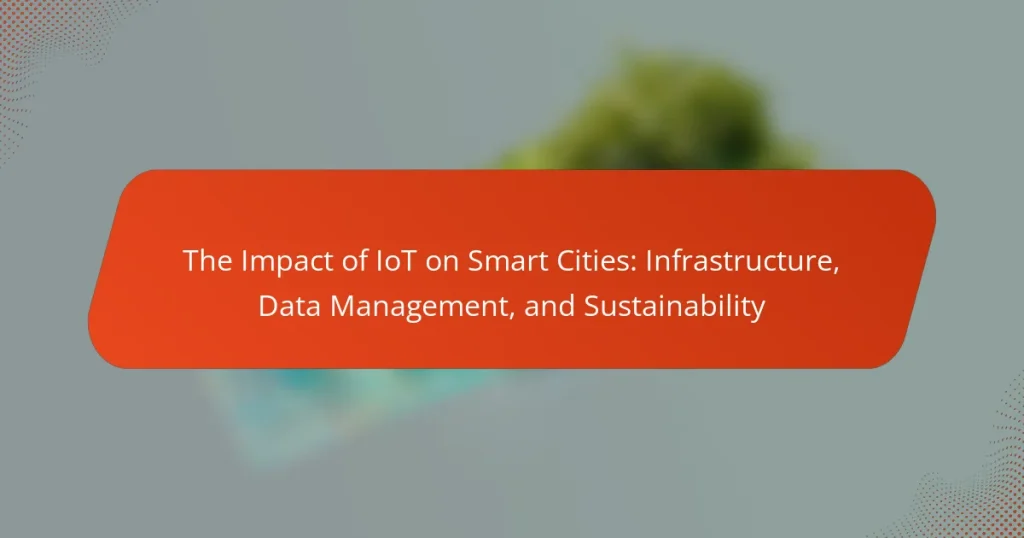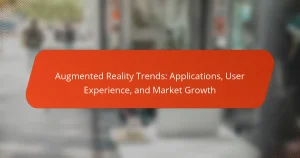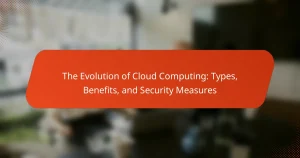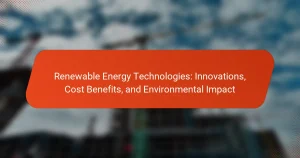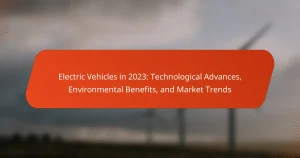The Internet of Things (IoT) significantly impacts smart cities by enhancing infrastructure efficiency, improving data management, and promoting sustainability. IoT technologies enable real-time monitoring of urban systems, such as traffic management and energy consumption, leading to optimized resource allocation and reduced operational costs. Smart devices, including traffic lights and energy grids, facilitate energy conservation and improved public safety. Additionally, effective implementation of IoT solutions requires robust infrastructure, reliable connectivity, and community engagement, contributing to a more livable and sustainable urban environment. According to research, cities adopting IoT can achieve operational efficiency gains of up to 30%.
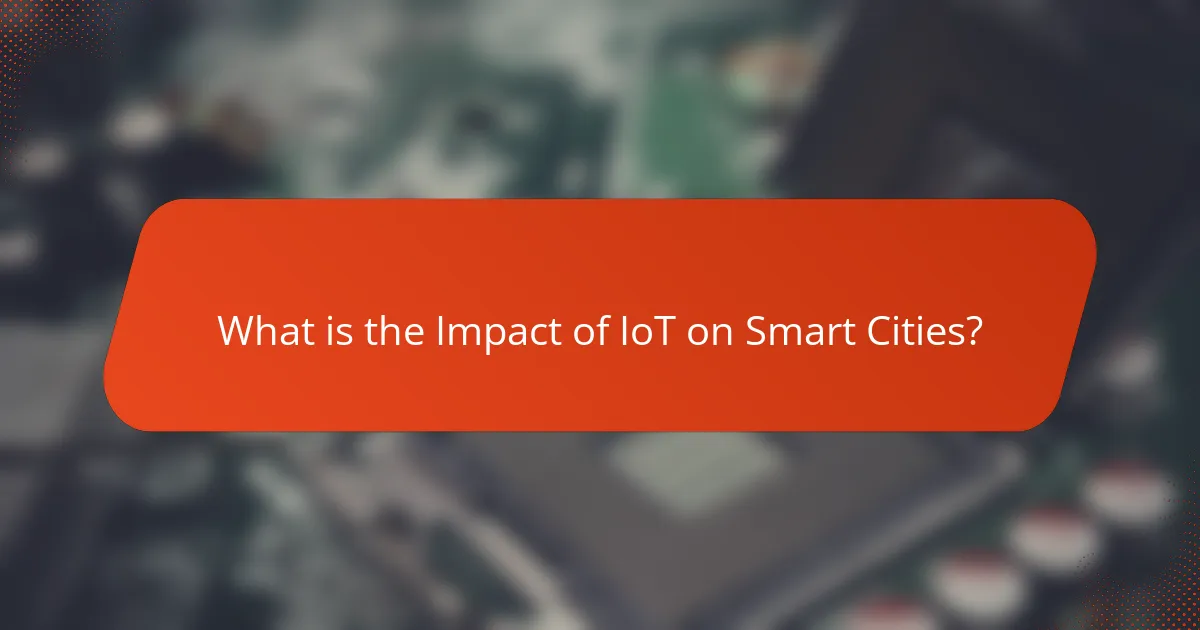
What is the Impact of IoT on Smart Cities?
The impact of IoT on smart cities is transformative and multifaceted. IoT enhances infrastructure efficiency through real-time monitoring of systems like traffic, utilities, and waste management. This technology enables cities to optimize resources and reduce operational costs. For instance, smart streetlights adjust brightness based on pedestrian movement, saving energy. IoT improves data management by collecting vast amounts of information for better urban planning. Cities can analyze this data to address issues like congestion and pollution. According to a report by McKinsey, cities can achieve up to 30% efficiency gains through IoT applications. Additionally, IoT fosters sustainability by promoting energy conservation and reducing carbon footprints. Smart grids allow for better energy distribution, minimizing waste. Overall, IoT is crucial in making urban environments more livable and sustainable.
How does IoT technology integrate into urban infrastructure?
IoT technology integrates into urban infrastructure by connecting devices and systems for enhanced efficiency and data collection. Smart sensors are deployed in various urban settings, such as traffic management and waste collection. These sensors gather real-time data, allowing city officials to monitor and respond to issues promptly. For instance, smart traffic lights adjust based on real-time traffic conditions to reduce congestion. Additionally, IoT devices in waste bins signal when they are full, optimizing collection routes. This integration improves resource management and reduces operational costs. According to a study by McKinsey, cities that adopt IoT can improve their operational efficiency by up to 30%.
What are the key components of IoT in smart cities?
The key components of IoT in smart cities include sensors, connectivity, data analytics, and applications. Sensors collect real-time data from the environment. Connectivity enables communication between devices and systems. Data analytics processes this data to derive actionable insights. Applications utilize these insights to improve city services and efficiency. For example, smart traffic systems reduce congestion by analyzing traffic patterns. Smart waste management systems optimize collection routes based on fill levels. These components work together to enhance urban living and sustainability.
How does IoT enhance connectivity within urban environments?
IoT enhances connectivity within urban environments by integrating smart devices and sensors. This integration allows real-time data collection and communication among various city systems. For example, smart traffic lights can adjust based on traffic flow data. Public transportation can provide real-time updates to commuters, improving efficiency. IoT systems also enable better energy management through smart grids. According to a report by McKinsey, cities implementing IoT technologies can improve operational efficiency by up to 30%. Enhanced connectivity leads to improved resource management and better quality of life for residents.
What role does data management play in smart cities?
Data management is crucial in smart cities for optimizing resources and enhancing decision-making. It involves the collection, storage, and analysis of vast amounts of data generated by IoT devices. Efficient data management enables real-time monitoring of urban systems, such as traffic, energy, and waste management. For instance, cities can use data analytics to reduce traffic congestion by adjusting traffic signals based on real-time data. According to a report by McKinsey, effective data management can improve city efficiency by up to 30%. Furthermore, it supports predictive maintenance of infrastructure, reducing costs and downtime. Ultimately, robust data management fosters sustainable urban development by enabling informed policy-making and resource allocation.
How is data collected and processed in smart city applications?
Data in smart city applications is collected through various IoT devices and sensors. These devices monitor environmental conditions, traffic patterns, and public services. Data is transmitted to centralized systems using wireless communication networks. The data is then processed using analytics and machine learning algorithms. This processing helps derive insights for urban planning and resource management. Real-time data processing enables immediate responses to city challenges. For example, traffic data can optimize signal timings to reduce congestion. Overall, data collection and processing enhance the efficiency of urban services.
What are the challenges of data management in IoT systems?
Data management in IoT systems faces several challenges. One major challenge is the vast amount of data generated by numerous devices. According to a report by Statista, the number of connected IoT devices is projected to reach 30.9 billion by 2025. This leads to difficulties in data storage and processing.
Another challenge is ensuring data security and privacy. IoT devices often collect sensitive information, making them targets for cyberattacks. Research from McKinsey indicates that 60% of IoT devices lack adequate security measures.
Interoperability among diverse devices also poses a significant challenge. Different manufacturers may use varying protocols, complicating data integration. A study by the International Telecommunication Union highlights that this lack of standardization can hinder effective data management.
Additionally, real-time data processing is essential for IoT applications. However, latency issues can arise due to network constraints, impacting the responsiveness of systems. The 2020 Cisco Global Cloud Index forecasts that global cloud data center traffic will increase by 25% annually, exacerbating this issue.
Lastly, data quality is a persistent concern. Inaccurate or incomplete data can lead to poor decision-making. A survey by IBM found that 30% of organizations struggle with data quality in their IoT initiatives.
How does IoT contribute to sustainability in urban areas?
IoT contributes to sustainability in urban areas by optimizing resource management and reducing waste. Smart sensors monitor energy consumption, allowing for real-time adjustments. This leads to decreased energy usage and lower carbon emissions. IoT systems also enhance water management through leak detection and efficient irrigation practices. In transportation, IoT facilitates smart traffic management, reducing congestion and emissions. According to a report by McKinsey, smart city technologies can reduce greenhouse gas emissions by up to 30%. Overall, IoT enhances urban sustainability through improved efficiency and resource conservation.
What sustainable practices are enabled by IoT technologies?
IoT technologies enable several sustainable practices, including energy management, waste reduction, and water conservation. Smart meters monitor energy usage in real-time, allowing for optimized consumption and reduced waste. For example, cities implementing smart grid technology have reported energy savings of up to 30%. IoT sensors in waste management systems track bin levels, optimizing collection routes and reducing fuel consumption. This practice can lead to a 20% decrease in operational costs. Additionally, smart irrigation systems use soil moisture data to efficiently manage water usage in agriculture. This can result in water savings of 30% to 50%. Overall, IoT technologies facilitate data-driven decisions that enhance sustainability in urban environments.
How can IoT help reduce urban energy consumption?
IoT can help reduce urban energy consumption by enabling smart energy management systems. These systems optimize energy usage in real-time through data collected from connected devices. For example, smart meters provide detailed insights into energy consumption patterns. This allows for the identification of peak usage times and inefficient appliances. Additionally, IoT-enabled streetlights can adjust brightness based on ambient light levels. Such adjustments can lead to significant energy savings. According to a report by McKinsey, cities implementing IoT solutions can reduce energy consumption by up to 30%. This demonstrates the potential of IoT in driving energy efficiency in urban environments.
How do IoT solutions improve public services in smart cities?
IoT solutions enhance public services in smart cities by enabling real-time data collection and analysis. This leads to improved resource management and operational efficiency. For example, smart traffic systems reduce congestion by optimizing traffic flow based on real-time data. IoT-enabled waste management systems monitor bin levels, ensuring timely collection and reducing costs. Additionally, smart lighting adjusts based on occupancy, saving energy and enhancing safety. Cities utilizing IoT solutions reported up to 30% reductions in operational costs. These improvements contribute to better citizen engagement and satisfaction.
What specific public services benefit from IoT integration?
Public services that benefit from IoT integration include transportation, waste management, and public safety. In transportation, IoT enables real-time traffic monitoring and smart traffic lights. This leads to reduced congestion and improved travel times. Waste management systems use IoT sensors to optimize collection routes based on bin fullness. This increases efficiency and reduces operational costs. Public safety services utilize IoT for surveillance and emergency response systems. This enhances security and enables quicker responses to incidents. Research has shown that cities implementing IoT solutions experience significant improvements in service efficiency and citizen satisfaction.
How does IoT enhance citizen engagement in urban governance?
IoT enhances citizen engagement in urban governance by facilitating real-time communication between citizens and local authorities. This technology enables the collection of data from various sources, such as sensors and devices, to inform governance decisions. For instance, smart city applications allow citizens to report issues like potholes or streetlight outages instantly.
Moreover, IoT platforms can provide citizens with access to information about city services and initiatives. This transparency fosters trust and encourages participation in local governance. According to a study by the McKinsey Global Institute, cities leveraging IoT technologies can improve citizen satisfaction by 30%.
Additionally, IoT promotes participatory budgeting, allowing citizens to contribute to financial decisions. This engagement leads to more responsive urban policies. Overall, IoT’s ability to connect citizens with their governments enhances accountability and civic participation.
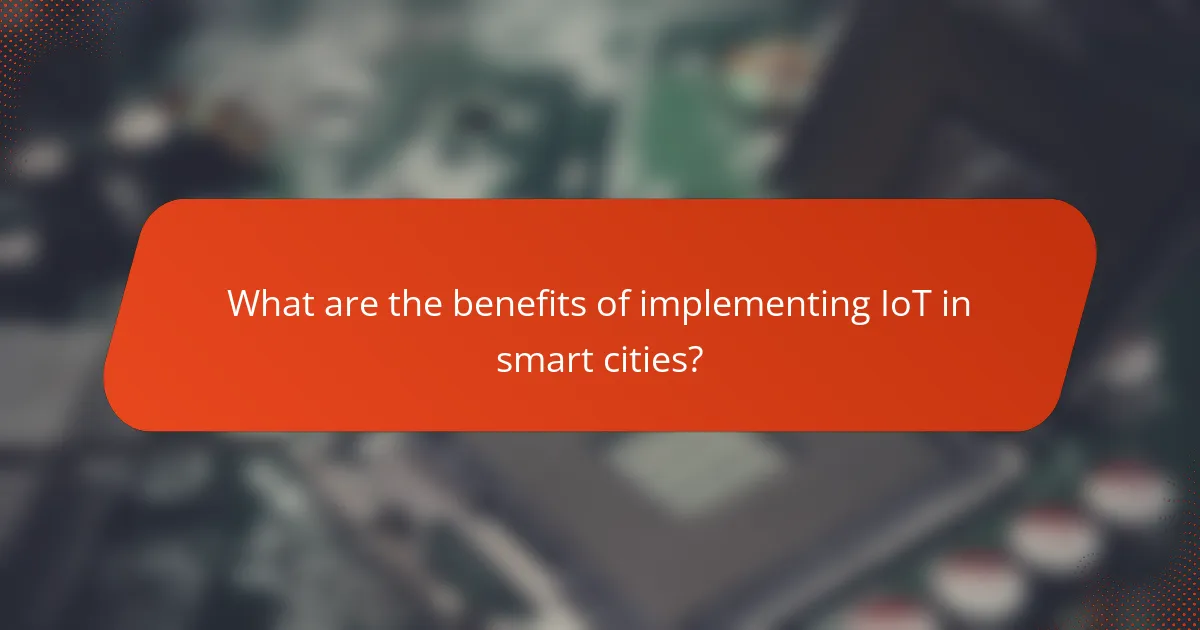
What are the benefits of implementing IoT in smart cities?
Implementing IoT in smart cities enhances efficiency and quality of life. IoT devices collect real-time data on traffic, energy use, and public services. This data allows for better resource management and optimization. For example, smart traffic lights can reduce congestion by adjusting to real-time traffic conditions. IoT can also improve energy efficiency through smart grids that monitor consumption patterns. Additionally, IoT systems enhance public safety with smart surveillance and emergency response systems. According to a report by McKinsey, cities that adopt IoT can improve their operational efficiency by up to 30%. These benefits contribute to sustainable urban development and improved citizen engagement.
How does IoT improve transportation systems?
IoT improves transportation systems by enhancing efficiency, safety, and user experience. Connected devices gather real-time data on traffic patterns and vehicle conditions. This information enables dynamic route optimization, reducing congestion. IoT systems also facilitate predictive maintenance of vehicles, minimizing breakdowns. Additionally, smart traffic lights adjust based on real-time traffic flow, improving overall traffic management. According to a study by McKinsey, implementing IoT in transportation can reduce travel time by 20-30%. Furthermore, IoT enhances safety through vehicle-to-vehicle communication, alerting drivers to potential hazards. Overall, IoT transforms transportation into a more efficient and safer system.
What technologies are used in smart transportation solutions?
Smart transportation solutions utilize various technologies. These include the Internet of Things (IoT), which connects vehicles and infrastructure. IoT enables real-time data collection and analysis. Another key technology is Artificial Intelligence (AI), which optimizes traffic management. AI can predict traffic patterns and reduce congestion. Vehicle-to-Everything (V2X) communication is also crucial. V2X allows vehicles to communicate with each other and infrastructure. Additionally, GPS and satellite navigation enhance route planning. Advanced sensors monitor road conditions and vehicle performance. These technologies collectively improve efficiency and safety in transportation systems.
How does real-time data impact traffic management?
Real-time data significantly enhances traffic management by providing immediate insights into traffic conditions. It allows for dynamic traffic signal adjustments based on current vehicle flow. This reduces congestion and improves travel times. Real-time data can also facilitate better incident detection and response. For instance, systems can identify accidents quickly and reroute traffic effectively. According to a study by the Texas A&M Transportation Institute, real-time data applications can reduce travel delays by up to 30%. Furthermore, such data supports predictive analytics for future traffic patterns. This leads to more informed infrastructure planning and resource allocation. Overall, real-time data transforms traffic management into a more responsive and efficient system.
What economic advantages does IoT bring to smart cities?
IoT brings significant economic advantages to smart cities. It enhances operational efficiency by optimizing resource management. For instance, smart traffic systems reduce congestion, saving time and fuel costs. IoT-enabled waste management systems streamline collection routes, lowering operational expenses. Moreover, real-time data analytics allows cities to make informed decisions, leading to cost savings. A report by McKinsey estimates that smart city technologies could generate up to $1.5 trillion in economic value annually. Additionally, IoT fosters innovation, attracting businesses and creating job opportunities. This economic growth contributes to improved public services and infrastructure.
How can IoT drive innovation in local economies?
IoT can drive innovation in local economies by enhancing efficiency and creating new business opportunities. Smart sensors and devices enable real-time data collection and analysis. This data helps local businesses optimize operations and reduce costs. For example, IoT applications in agriculture can increase crop yields through precision farming techniques. In transportation, IoT can improve traffic management systems, reducing congestion and travel times. According to a report by McKinsey, cities that adopt IoT technologies can increase their GDP by 1.5% to 3% annually. Furthermore, IoT fosters collaboration between public and private sectors, leading to innovative solutions tailored to local needs.
What are the cost savings associated with IoT implementations?
IoT implementations can lead to significant cost savings across various sectors. These savings arise from improved operational efficiency and reduced resource wastage. For instance, smart sensors can monitor energy usage in real-time, leading to reductions in energy costs by up to 30%. Predictive maintenance enabled by IoT can decrease equipment downtime, saving companies an average of 10% to 20% in maintenance costs.
Additionally, IoT devices can optimize supply chain management, resulting in lower inventory costs by improving demand forecasting accuracy. A study by McKinsey found that IoT can help reduce logistics costs by 15% to 25%. Furthermore, smart city initiatives can reduce operational costs for municipalities by automating services, leading to savings in labor and maintenance expenses.
Overall, the integration of IoT technologies can yield substantial financial benefits across multiple domains.
What are the potential risks and challenges of IoT in urban settings?
The potential risks and challenges of IoT in urban settings include security vulnerabilities, data privacy concerns, and infrastructure dependency. Security vulnerabilities arise from the interconnected nature of devices. This interconnectivity can lead to unauthorized access and cyberattacks. Data privacy concerns stem from the collection and analysis of personal information. Citizens may feel their privacy is compromised without adequate safeguards. Infrastructure dependency means that cities may rely heavily on IoT systems. A failure in these systems can disrupt essential services like transportation and utilities. Additionally, interoperability issues can arise between different IoT devices and platforms. This can complicate integration and functionality. Lastly, the digital divide may exacerbate inequalities in access to IoT benefits. Not all urban residents may have equal access to the technology.
How do security concerns affect IoT deployment in smart cities?
Security concerns significantly hinder IoT deployment in smart cities. These concerns include data breaches, unauthorized access, and system vulnerabilities. Such risks can lead to compromised public safety and privacy. For instance, a 2020 report by the Internet of Things Security Foundation indicated that 98% of IoT devices have security vulnerabilities. This creates distrust among stakeholders and can delay implementation. Additionally, stringent regulations may arise to address these security issues, complicating deployment processes. Ultimately, security concerns necessitate robust measures that can increase costs and extend timelines for IoT integration in smart cities.
What measures can be taken to mitigate risks associated with IoT?
Implementing strong security protocols is essential to mitigate risks associated with IoT. This includes using encryption to protect data transmitted between devices. Regular software updates can patch vulnerabilities in IoT devices. Network segmentation helps isolate IoT devices from critical systems. Additionally, employing strong authentication methods prevents unauthorized access. Monitoring network traffic can detect unusual activity early. Establishing clear data governance policies ensures responsible data management. Training users on security best practices reduces human error risks. These measures collectively enhance the security posture of IoT systems in smart cities.
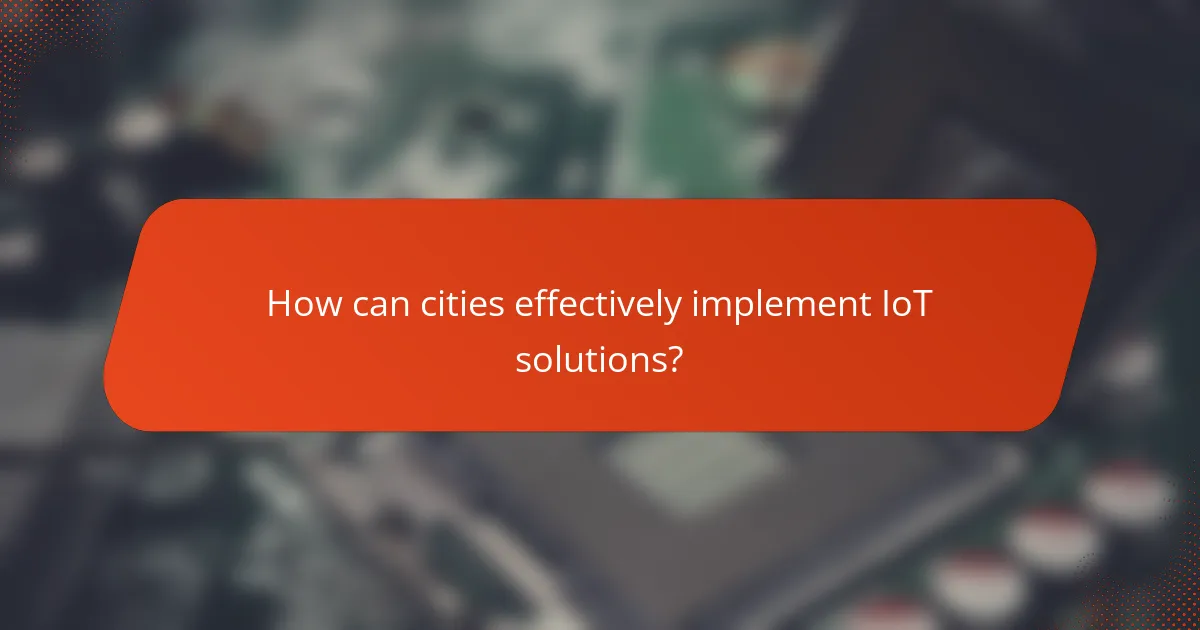
How can cities effectively implement IoT solutions?
Cities can effectively implement IoT solutions by establishing a robust infrastructure. This includes investing in reliable connectivity, such as 5G networks. Cities should prioritize data management strategies to handle the vast amounts of data generated. Implementing secure cloud storage and analytics platforms is essential for effective data utilization. Collaboration with technology partners can enhance the integration of IoT devices. Cities must also engage with the community to understand their needs and concerns. Pilot programs can test IoT applications before full-scale deployment. According to a study by McKinsey, cities leveraging IoT can improve operational efficiency by up to 30%.
What best practices should cities follow for IoT integration?
Cities should prioritize security and privacy when integrating IoT. Implementing strong encryption and access controls protects sensitive data. Interoperability is also crucial; devices must communicate seamlessly. Standardizing protocols enhances compatibility across systems. Additionally, cities should involve stakeholders in planning. Engaging citizens ensures that their needs are met. Data analytics should be utilized for decision-making. Analyzing real-time data improves city services and resource allocation. Finally, continuous monitoring is essential. Regular assessments help identify vulnerabilities and optimize performance. These practices lead to effective and sustainable IoT integration in urban environments.
How can stakeholder collaboration enhance IoT initiatives?
Stakeholder collaboration can significantly enhance IoT initiatives by fostering shared resources and expertise. When stakeholders, including government, businesses, and communities, collaborate, they can align their goals. This alignment leads to more effective data sharing and technology integration. Collaborative efforts can also drive innovation through diverse perspectives and skills. According to a McKinsey report, cities that engage multiple stakeholders in IoT projects see 30% faster implementation times. Enhanced collaboration improves trust and accountability among participants. This ultimately results in more sustainable and efficient smart city solutions.
What role does policy play in shaping IoT strategies?
Policy plays a crucial role in shaping IoT strategies by establishing regulatory frameworks. These frameworks guide the development, deployment, and management of IoT technologies. Policies influence data privacy, security standards, and interoperability among devices. For instance, the General Data Protection Regulation (GDPR) in Europe sets strict guidelines for data handling in IoT applications. Additionally, policies can incentivize innovation through funding and support for research initiatives. They also promote collaboration between public and private sectors, enhancing the effectiveness of IoT implementations. Effective policy-making ensures that IoT strategies align with broader goals of sustainability and urban development in smart cities.
What future trends can we expect in IoT and smart cities?
Future trends in IoT and smart cities include increased integration of artificial intelligence. AI will enhance data analysis and decision-making processes. Another trend is the rise of edge computing. This technology reduces latency by processing data closer to the source. Additionally, the adoption of 5G networks will facilitate faster communication between devices. This will enable real-time data exchange and improve service delivery.
Sustainability initiatives will gain traction, focusing on energy efficiency and resource management. Smart grids and smart waste management systems will become more prevalent. Enhanced cybersecurity measures will also be crucial as cities become more connected. This will protect sensitive data from potential threats. Finally, citizen engagement through mobile applications will grow. This will allow residents to participate in urban planning and service feedback.
How will advancements in technology influence smart city development?
Advancements in technology will significantly influence smart city development by enhancing infrastructure, improving data management, and promoting sustainability. Technologies such as the Internet of Things (IoT) enable real-time data collection and analysis. This data helps city planners optimize traffic flow and reduce congestion. Smart sensors can monitor air quality, leading to better environmental policies. Additionally, advancements in renewable energy technologies support the integration of sustainable energy sources. Cities can implement smart grids to manage energy distribution more efficiently. Research by McKinsey Global Institute indicates that smart city technologies could reduce urban energy consumption by up to 30%. These advancements collectively create more efficient, responsive, and sustainable urban environments.
What emerging IoT applications could reshape urban living?
Emerging IoT applications that could reshape urban living include smart waste management systems. These systems use sensors to monitor waste levels in bins. This data optimizes collection routes and schedules, reducing costs and emissions. Another application is smart street lighting. It adjusts brightness based on pedestrian and vehicle presence, enhancing energy efficiency.
Smart traffic management systems are also significant. They analyze real-time traffic data to optimize signal timings. This reduces congestion and improves air quality. Additionally, smart parking solutions help drivers find available spaces quickly. They reduce the time spent searching for parking, lowering carbon footprints.
Furthermore, IoT-enabled environmental monitoring applications track air quality and noise levels. This data informs city planners and residents about urban health. These applications create a more sustainable and efficient urban environment.
What practical steps can cities take to leverage IoT for sustainability?
Cities can leverage IoT for sustainability by implementing smart waste management systems. These systems use sensors to monitor waste levels in bins. This data allows for optimized collection routes, reducing fuel consumption and emissions.
Additionally, cities can deploy smart water management solutions. Sensors can detect leaks and monitor usage patterns. This helps in conserving water resources and minimizing waste.
Smart energy management systems can also be utilized. IoT devices can monitor energy consumption in real-time. This data enables cities to promote energy efficiency and reduce overall consumption.
Moreover, cities should invest in smart transportation solutions. IoT can facilitate real-time traffic monitoring and management. This helps in reducing congestion and lowering carbon emissions.
Finally, cities can engage citizens through IoT-enabled platforms. These platforms can provide real-time feedback on sustainability practices. Active citizen participation can further enhance the effectiveness of sustainability initiatives.
The primary entity of the article is the Internet of Things (IoT) and its impact on smart cities. The article outlines how IoT enhances urban infrastructure efficiency through real-time monitoring, data management, and sustainability practices. Key components discussed include the integration of smart sensors, connectivity, and data analytics, which collectively improve resource management and public services. Additionally, the article addresses challenges such as data security and interoperability while highlighting the economic advantages and future trends associated with IoT in urban settings.
